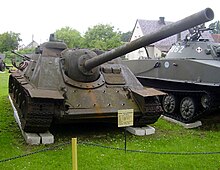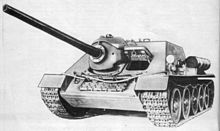SU-85
| SU-85 | |
|---|---|

SU-85 |
|
| General properties | |
| crew | 4th |
| length | 8.15 m |
| width | 3.00 m |
| height | 2.45 m |
| Dimensions | 29.6 t |
| Armor and armament | |
| Armor | 14-75 mm |
| Main armament | 85mm D-5S L / 52 cannon |
| agility | |
| drive |
Twelve-cylinder - diesel engine W-2-34 500 hp (368 kW) |
| suspension | Compression springs |
| Top speed | 47 km / h |
| Power / weight | 17 hp / t |
| Range | 200 km |
The SU-85 ( Russian СУ-85 ) was a Soviet tank destroyer of the Second World War . SU is the Russian abbreviation for S amochodnaja U stanowka ( self-propelled gun ).
development
With the appearance of the heavy German tanks on the Eastern Front in the summer of 1943, the T-34s of the Soviet Army fell behind. A tank was urgently needed that could cope with the new Panther and Tiger tanks . A tiger captured near Leningrad was subjected to intensive fire tests. Only the 85 mm Flak L / 52 and the 122 mm A-19 Korpskanone were able to penetrate the armor of the Tiger at a greater distance. Therefore, Uralmash in Sverdlovsk received the order to develop a new tank destroyer which, in order to save development time, was to be based on the chassis of the T-34 and the structure of the SU-122 . The ball diaphragm and structure of the SU-122 did not work well and had to be redesigned. The 85 mm flak was modified to the D-5S and equipped with the new TSch-15 telescopic sight. It was installed to the right next to the driver's seat. In the course of development, three prototypes were constructed (SU-85 I, SU-85 II, SU-85 IV), among which the SU-85 II was ultimately chosen. As many components as possible were taken over from the T-34 in order to avoid time-consuming training for new crews and to keep production costs as low as possible.
production
From August 1943 to September 1944, 2,329 SU-85 tank destroyers were produced. When the T-34/85 appeared, the SU-85 was developed into the SU-100 and production was discontinued. In July 1944, however, there were still problems with the manufacture of ammunition for the D-10S cannon of the SU-100. In order to bridge the time until the SU-100 was ready for the front line, the already fully developed and ready-to-use chassis of the SU-100 was armed with the 85-mm D-5S cannon and delivered. This newly created tank destroyer was called the SU-85M and differed from the SU-85 (due to the chassis) in the front armor (75 mm instead of 45 mm for the SU-85). Up to the start of production of the SU-100 in December 1944, a total of 315 SU-85M had been produced.
commitment
Red Army
The SU-85 were used in various structures. In addition to independent battalions with 12 guns each, subordinate to the corps or army commands, there were artillery regiments with four batteries with 16 guns each and a T-34 command tank. The operational principles provided that the SU-85 fought the heavy German tanks from a safe distance.
For the first time, SU-85s were used in August 1943 during the Battle of the Dnieper . There it was shown that the SU-85 could be used successfully against the German tanks. Due to its low silhouette, it was also very suitable for ambushes, as it was relatively difficult to detect by the enemy.
Wehrmacht
Wehrmacht and Waffen-SS used captured vehicles as SU-85 (r) tank destroyers because there weren't enough tank destroyers available. To prevent the SU-85 (r) from being attacked by its own troops, they were marked with oversized bar crosses on both sides.
Technical specifications
- Armament
- Vertical directional range: −5 to + 20 °
- Horizontal directional range: ± 12 °
- Penetration performance against Tiger I : bow armor up to 800 meters, side up to 1350 meters, tower side 800 to 1000 meters
- Combat set: 49 grenades
- Armouring of the hull in mm
- sideways: 45
- above: 14
- below: 20
- Cannon mantlet: up to 75
Armored tractors

As early as 1943, damaged but still roadworthy T-34 and SU-85 and later the SU-100 were converted into T-34T armored tractors and T-34TB armored recovery vehicles. For this purpose, the cannons were removed from the SU, the opening of the spherical shutter was closed with an armored plate and the chassis was equipped with a makeshift crane and workshop equipment.
Around 200 of these tractors were in service with the NVA until 1970, after which they were replaced by armored tractors and armored recovery vehicles based on the T-55 and assigned to the reserve.
literature
- Alexander Lüdeke : Allied tanks . 1939-1945. Motorbuch, Stuttgart 2009, ISBN 978-3-613-03108-1 (type compass).
- Matthew Hughes, Chris Mann: T-34 tanks . Karl Müller, Erlangen 1999, ISBN 978-3-86070-799-9 , p. 86–91 (English: The T-34 tank . Translated by Jürgen Brust).
Web links
- SU-85. In: panzer-archiv.de. Panzer Archive, January 15, 2015, accessed January 15, 2015 .
Individual evidence
- ↑ a b c Matthew Hughes, Chris Mann: T-34 tanks . Karl Müller, Erlangen 1999, ISBN 978-3-86070-799-9 , p. 88.90–91 (English: The T-34 tank . Translated by Jürgen Brust).
- ↑ Soviet SU-85 Tank Destroyer. In: wwiivehicles.com. Retrieved January 15, 2015 .
- ^ Archive Awareness. SU-85 and SU-57. In: tankarchives.blogspot.de. Retrieved January 15, 2015 .
- ^ Archive Awareness. Soviet 85mm Guns vs Tigers. In: tankarchives.blogspot.ca. Retrieved January 15, 2015 .
- ^ Jörg Siegert , Helmut Hanske: Main battle tanks of the NVA . Motorbuch, Stuttgart 2011, ISBN 978-3-613-03294-1 , p. 23-26 .


